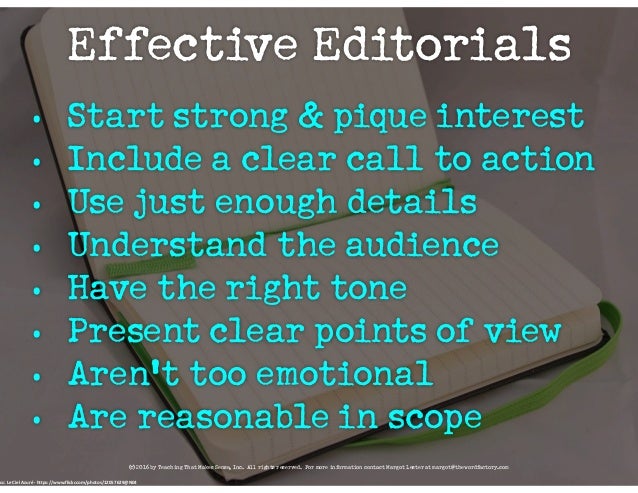At this time, I should have your topic choices. (See Friday's blog;) You should have also made progress on your 8 sources for your Works Cited. Take a moment today to review the mechanics of an editorial. (Seven slides below) and then read the assignment material. Thanks
REVIEW

Remember that an editorial is the only type of newspaper writing that is
SUBJECTIVE (biased, opinionated, non-neutral), unlike objective articles that
are non-biased, neutral, lack opinion and are based solely on facts.
1. To anchor yourself, please review the editorial format and example above.
2. Monday and Tuesday are research days, whilst Wednesday and Thursday are for your writing. Your editorials are due by the close of class on Thursday, with the exception of those who receive the extended time. You have until midnight. This is the last grade for this quarter. Are you missing material? Check your parent connect. Late material is now worth 50 points. I will not be accepting any late material after Thursday, April 5.
3. Directions for your editorial
Times New Roman
Size 12 font
minimum 300 words
Set up with a headline and your name as a byline (no need for MLA heading)
Works cited page with a minimum of 8 sources. Format correctly; that includes alphabetical order.
The grading rubric is the same as for an argumentative essay.
Editorial Format:
All four of the editorial types follow this simple, basic format when written.
Editorials are get to the point quickly. You can use a quote in an editorial,
if you wish, but most don’t. Use one when it comes from a credible source and
will support your point or stance.
Do not use “I” or
“me” in your editorials.
Paragraph 1 –
Introduction
States the topic you will be discussing and it is usually
one or two sentences. Save your stance
and supporting facts until later. As
with all introductions or ledes, this should be attention-grabbing and draw the
reader in.
Paragraph Two
–Reaction
This is where you actually state your opinion on the topic
you mentioned. It should be only one or
two sentences.
Paragraph Three
through Five – Supportive Arguments for your stance
These paragraphs are where you sell your opinion. You must use examples, strong facts, and
details to support your stance. Each
paragraph should be two or three sentences.
Each paragraph contains a different argument for your opinion.
Paragraph Six – The
Other Side
By making a counterargument (giving the other side), you are
making your own argument stronger. Only
one paragraph is needed. After you state
the other side, you must then refute it. In other words, give reasons showing
why that side is not valid.
Paragraph Seven –
Suggestions or Solution
What do you propose to solve the issue? This should be one paragraph. Provide some options to fix the problem.
Paragraph Eight –
Conclusion
End with an appeal to the readers. What do you want them or
officials to do? What message do you want them to away from the editorial?
EXAMPLE
Paragraph I:
Introduction
The warning labels on cigarette
cartons tell the story: smoking can cause lung cancer, heart disease,
emphysema, premature birth and injury to babies born to smokers. Yet, despite
the dangers, cigarettes are readily available in convenience stores, gas
stations, and liquor stores.
Paragraph II:
Reaction
Although tobacco companies may
defend their products, numerous studies have shown that cigarettes are as addictive
as any illegal drug and as treacherous as a drunk driver. Like those societal
hazards, cigarettes should be officially outlawed.
Paragraph III:
Supporting arguments and facts
Cigarette
smoking is one of the leading causes of death, cancer and other disease in the
United States. Just look at the statistics from the U.S. Centers for Disease
Control and Prevention: Health problems traced to cigarette smoking lead to one
of every five deaths, more than HIV, illegal drugs, car accidents, suicides and
murders. Smoking is blamed for the majority of lung cancer deaths among men and
women, and boosts the rate of heart disease, bronchitis and emphysema.
Paragraph IV:
Supporting arguments and facts
Smokers are
not the only ones risking illness and death from cigarettes; second-hand smoke
also kills and debilitates. A 2006 report by the U.S. Surgeon General’s office
concluded that nonsmokers have a substantially increased risk of heart disease
and lung cancer after being exposed to second-hand, or environmental, tobacco smoke. Many experts also trace high incidents of
asthma and other respiratory ailments among children to second-hand smoke,
illustrating how insidiously cigarette smoke can maim the innocent.
Paragraph V:
Supporting arguments and facts
Even with clear
evidence linking serious health problems to cigarettes, many smokers are unable
to quit. According to the American Cancer Society, about 70 percent of smokers
express a desire to stop smoking and about 40 percent try to give up cigarettes
each year. However, only about four to seven percent actually manage to break
the grip of cigarette addiction. The rest continue to endanger their lives and
the lives of others.
Paragraph VI: The
Other Side
Tobacco companies, such as Philip
Morris International, have funded studies disputing the health risks associated
with smoking and produce “safer” cigarettes that supposedly cut down on
dangers. On its website, Philip Morris also defends the right of businesses to
allow smoking in public places. Yet, even the company admits, “cigarette
smoking causes lung cancer, heart disease, emphysema and other serious diseases
in smokers ...There is no such thing as a "safe" cigarette.”
Paragraph VII:
Suggestions or solutions
Cigarettes
are deadly; the risks are real; the benefits are non-existent. The only way to
stop the danger is to stop the sale of cigarettes altogether.
Paragraph VIII:
Conclusion
. It is time politicians took decisive action.
It is time for cigarettes to be declared illegal.








No comments:
Post a Comment